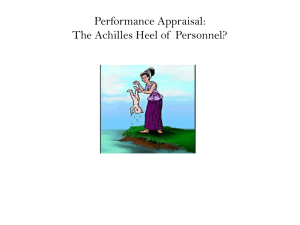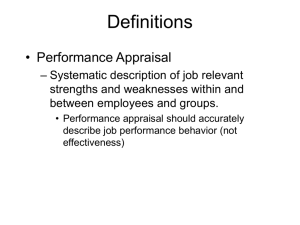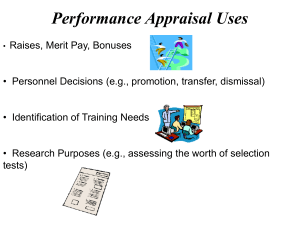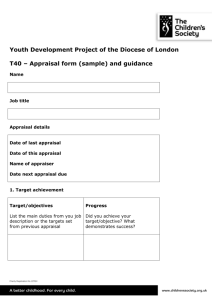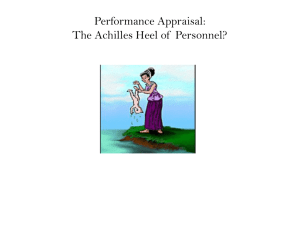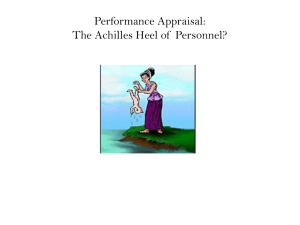Performance Appraisal Uses
advertisement
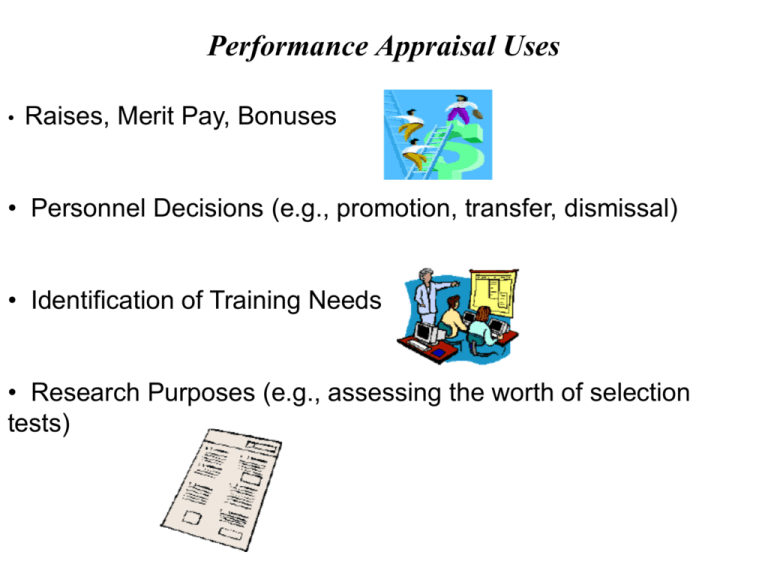
Performance Appraisal Uses • Raises, Merit Pay, Bonuses • Personnel Decisions (e.g., promotion, transfer, dismissal) • Identification of Training Needs • Research Purposes (e.g., assessing the worth of selection tests) Basic Performance Appraisal Process Conduct a Job Analysis (e.g., specify tasks and KSAs) Develop Performance Standards (e.g., define what is superior, acceptable, and poor job performance) Develop or Choose a Performance Appraisal System Performance Appraisal Process Observation • Selective Attention • Timing • Structure • Frequency Storage • Encoding of Information (e.g., categorization) • Short vs. Long-term • Memory Evaluation • Retrieve Information • Combine information • Decision-making (judgment) Sources of Information 1) Supervisors (most common) • Role Conflict (e.g., judge and trainer/teacher) • Motivation • Time availability • Friendship 2) Co-Workers (Peers) • Friendship bias • Leniency • High level of accuracy • Best used as a source of feedback Sources of Information (cont) 3) Self • Lots of knowledge • Leniency effect • Good preparation for performance appraisal meeting (conducive for dialog) 4) Subordinates • Biases (e.g., # of subordinates, type of job, expected evaluation from supervisor) 5) Client • Good source of feedback • Negativity bias Subjective Appraisal Methods (can be used with any type of job) Relative Methods 1) Ranking 1st _____ 2nd_____ 3rd _____ 2) Pair Comparison Employee-1 _____ versus Employee-2 _____ Employee-1 _____ versus Employee-3 _____ etc. • Both are difficult to use with a large number of subordinates Subjective Appraisal Methods (cont.) Absolute Methods 1) Narrative essay • Unstructured (e.g., content, length) • Affected by the writing ability of supervisors and time availability 2) Graphic Rating Scale (most common) _____ _____ _____ _____ _____ Very Average Excellent Poor ~ Basic Rating Scale Errors ~ 1) Leniency (positive bias) _____ Very Poor _____ _____ _____ _____ Average Excellent 2) Severity (negative bias) _____ Very Poor _____ _____ _____ _____ Average Excellent 3) Central Tendency (midpoint) _____ Very Poor _____ _____ _____ _____ Average Excellent All lead to a restriction in the range of performance scores Halo Error Responsibility Commitment Initiative Sensitivity Judgment Communication High ratings on other performance dimensions Observation of specific behavior (s) (e.g., volunteers to work overtime) 3. Problem Solving/Troubleshooting Definition: Uses a logical, step-by step approach to identify and solve process problems 1 2 Well Below Expectations Below Expectations Fails to understand how equipment and processes interrelate Does not complete checklists or other required forms Is not able to identify root causes of process deviations Does not consistently meet A2E expectations Depends on others to solve problems 3 Meets Expectations 4 5 Consistently Exceeds Expectations Uses available resources (e.g., drawings, checklists, forms, people—engineers, data historian) to determine the root cause of problems Selects and interprets data to solve problems Investigates the nature of equipment and process malfunctions on an ongoing basis Participates in A2E efforts Outstanding Develops novel, safe and effective solutions to current problems Anticipates problems before they occur and suggests solutions Takes ownership in problem solving and sees it through to completion Effectively leads problem solving efforts (e.g., A2E, handles complicated analysis requests on one’s own) Behavioral Examples of Rating:_____________________________________________________________________ ______________________________________________________________________________________________ ______________________________________________________________________________________________ ______________________________________________________________________________________________ 2. Technical Ability Definition: Uses mechanical, electrical and process equipment, tools, and principles properly 1 Well Below Expectations 2 3 4 5 Below Expectations Meets Expectations Consistently Exceeds Expectations Outstanding Cannot describe the parts and functions of various equipment (e.g., valves, pumps, motors) Skips steps in the procedures when performing job tasks Incorrectly uses tools and other equipment Cannot read and interpret EFDs, PFDs, blueprints and schematics Does not accurately perform basic mathematical calculations or conversions Interprets graphs, charts and diagrams accurately Examines relevant information (e.g., tank levels, set points) before making process adjustments Continuously learns and improves one’s job knowledge Can explain to others how to do their job Demonstrates knowledge of different work areas (e.g., lab) and how these interact with each other Can train others on how to do their job Independently resolves any complex work-related request Suggests ways to improve system functioning (e.g., increase yield, prevent waste) Behavioral Examples of Rating:_____________________________________________________________________ ______________________________________________________________________________________________ ______________________________________________________________________________________________ ______________________________________________________________________________________________ ~ Subjective Appraisal Methods ~ Behavioral Methods (Use of critical incidents; examples of good and poor job behavior collected by job experts over time) Behavior Observation Scales (BOS) • Rate the frequency in which critical incidents are performed by employees • Sum the ratings for a total “performance” score 1) Assists others in job duties. _____ _____ _____ _____ Never Usually _____ Always 2) Cleans equipment after each use. _____ _____ _____ _____ _____ Never Usually Always Behaviorally Anchored Rating Scale (BARS) Process 1) Generate critical incidents (examples of good and poor job performance) 2) Place critical incidents Into performance dimensions (e.g., Responsibility, Initiative, Safety) 3) Retranslation Step (do step # 2 again with a separate group of job experts. Discard incidents where disagreement exists as to which dimension in which they belong) 4) Calculate the mean and standard deviation of each critical incident (discard those with a large standard deviation) 5) Place critical incidents on a vertical scale ~ BARS (Pros and Cons) ~ Process involves various employees (increases chances of usage) J Job specificity (different BARS need to be developed for ach position) Not any better at reducing common rating scale errors (e.g., leniency, halo) Time consuming Performance Appraisal & Self-Fulfilling Prophecies Supervisor Expectancy Leadership Behaviors Subordinate Self-Expectancy Subordinate Performance Subordinate Motivation Objective Appraisal Data 1) Production Data (e.g., sales volume, units produced) • When observation occurs (timing), and how data is collected • Fairness and relevancy issue • Potential limited variability • Limitations regarding supervisory personnel 2) Personnel Data • Absenteeism (excused versus unexcused) • Tardiness • Accidents (fault issue) Performance Appraisal Training 1) Frequent observation of performance and feedback (both positive and negative) 2) Recordkeeping (ongoing if possible) 3) Encourage self-assessment of employees 4) Focus on behaviors (not traits) 5) Use specific behavioral criteria and standards 6) Set goals for employees (specific and challenging ones) 7) Focus on how to observe job behaviors and provide incentives Legally Defensible Appraisal Systems • Ensure that procedures for personnel decisions do not discriminate on the basis of the race, sex, national origin, religion, or age of those affected by such decisions. • Use objective and uncontaminated data whenever they are available. • Provide a formal system of review or appeal to resolve disagreements regarding appraisals. • Use more than one independent evaluator of performance. • Use a formal, standardized system for personnel decisions. • Ensure that evaluators have ample opportunity to observe and rate performance if ratings must be made. • Avoid ratings on traits such as dependability, drive, aptitude, or attitude. • Provide documented performance counseling prior to performance,based termination decisions. Legally Defensible Appraisal Systems (cont) • Communicate specific performance standards to employees. • Provide raters with written instructions on how to complete performance evaluations. • Evaluate employees on specific work dimensions, rather than on a single overall or global measure. • Require documentation in terms of specific behaviors (e.g., critical incidents) for extreme ratings. • Base the content of the appraisal form on a job analysis. • Provide employees with an opportunity to review their appraisals. • Educate personnel decision-makers regarding laws on discrimination. Intercept Bias (Test) Satisfactory Minority Performance Criterion Non minority Unsatisfactory Reject Accept Predictor Score Equal validity, unequal predictor means - Job performance is equal - Test scores are greater for non-minorities Satisfactory Non minority Performance Criterion Minority Unsatisfactory Reject Accept Predictor Score Equal validity, unequal criterion means - Equal test scores; Minorities performing less well on job (over predicting performance) - Minorities hired same as non minorities but probability of success is small. Can reinforce existing stereotypes.
